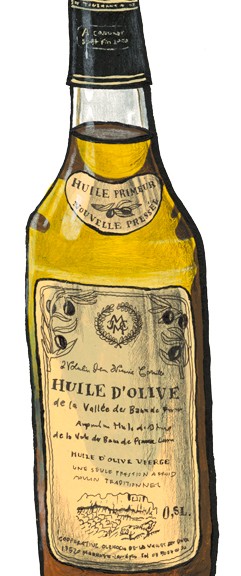Why does this olive oil from France taste different than an olive oil from Italy? It’s more than just a difference in geography. Here are three key factors that give Maussane, the olive oil from Provence that has a cult following, its je ne sais quoi.
1. Maussane is made with sweet olives.
The varietal(s) of olives used is one of the biggest contributors to an oil’s flavor. There are hundreds and hundreds of different olives grown around the world. Around the Mediterranean, different regions grow different olives just like different regions grow different grapes. Each varietal has its own flavors. In Italy, many of the common varietals, like Frantoio from Tuscany or Coratina from Puglia, are bitter, grassy, and spicy. In France, the olives tend to be softer, less bitter. Maussane is a blend of five olives: Salonenque, Grossane, Beruguette, Verdale, and Picholine. They’re known for their sweetness.
2. The olives used to make Maussane are picked late in the season.
When the farmer chooses to pick the olives is another huge factor in creating the oil’s flavor. All olives start green and, if left to mature fully, will become black. Like any fruit, if you pick an olive when it’s greener (less ripe), it’ll be harder and more bitter. If you pick it when it’s blacker, the riper fruit will have sweeter, richer flavors. Many olive oil producers in Italy prefer to pick their olives when they’re greener, which contributes to bolder, more peppery flavors in the oil. In France, people tend to wait until the olives are blacker, which makes for softer, more buttery tasting oils. One Italian exception is Roi from Liguria in northern Italy (which happens to be right next to France)—at Roi they pick the olives later when they’re black, too.
3. To make Maussane, they ferment the olives for a few days before pressing them.
Typically, to produce good olive oil, after you pick the olives from the trees you want to get them to the mill and turned into oil as quickly as possible. A good rule of thumb is under 24 hours. But Maussane is made with the fruité noir, or “black fruity” method, an old tradition in Provence. Instead of milling the olives immediately, they’re left to rest and ferment for a few days. That time fermenting brings out huge, deep, rich flavors that are totally different from the sharper, more assertive flavors that most Italian oils have these days.
Maussane is our richest, most buttery oil.
It tastes incredibly olive-y, like a black olive tapenade in liquid form. One of its fans once told me, “if you love olives, you’ll want to marry this oil.” It has a super thick, almost buttery mouthfeel, so you could use it in place of butter; I used to have a coworker who poured Maussane over her popcorn in place of melted butter. It’s phenomenal poured over fish or golden roasted potatoes. It’s great for gently scrambled eggs. And it makes the ideal dressing for a Salade niçoise with tomatoes, tuna, hard boiled egg, olives, and anchovies.

